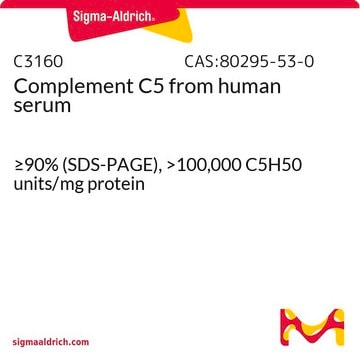C6852
L-Cysteine hydrochloride monohydrate
98.5-101.0% dry basis, suitable for cell culture, non-animal source, meets EP, USP testing specifications
Synonim(y):
L-Cysteine hydrochloride hydrate (1:1:1)
About This Item
Polecane produkty
product name
L-Cysteine hydrochloride monohydrate, from non-animal source, suitable for cell culture, meets EP, USP testing specifications
pochodzenie biologiczne
non-animal source
Poziom jakości
agency
meets EP testing specifications
meets USP testing specifications
Próba
98.5-101.0% dry basis
Postać
powder or crystals
aktywność optyczna
[α]20/D 6.1 to 7.8°, c = 8 in 1 M HCl
[α]25/D 5.7 to 6.8°, c = 8 in HCl (6 N)
metody
cell culture | mammalian: suitable
zanieczyszczenia
endotoxin, tested
kolor
white
rozpuszczalność
water: 1 g/10 mL, clear, colorless
ślady kationów
Fe: ≤10 ppm
NH4+: ≤0.02%
Zastosowanie
pharmaceutical (small molecule)
grupa funkcyjna
(sulfhydryl)
temp. przechowywania
room temp
ciąg SMILES
O.Cl.N[C@@H](CS)C(O)=O
InChI
1S/C3H7NO2S.ClH.H2O/c4-2(1-7)3(5)6;;/h2,7H,1,4H2,(H,5,6);1H;1H2/t2-;;/m0../s1
Klucz InChI
QIJRTFXNRTXDIP-JIZZDEOASA-N
Szukasz podobnych produktów? Odwiedź Przewodnik dotyczący porównywania produktów
Powiązane kategorie
Opis ogólny
Zastosowanie
Działania biochem./fizjol.
Cechy i korzyści
- Suitable for Cell Culture and Biochemical research
- High-quality compound suitable for multiple research applications
Inne uwagi
produkt podobny
Kod klasy składowania
11 - Combustible Solids
Klasa zagrożenia wodnego (WGK)
WGK 1
Temperatura zapłonu (°F)
Not applicable
Temperatura zapłonu (°C)
Not applicable
Środki ochrony indywidualnej
dust mask type N95 (US), Eyeshields, Gloves
Choose from one of the most recent versions:
Certyfikaty analizy (CoA)
Don't see the Right Version?
If you require a particular version, you can look up a specific certificate by the Lot or Batch number.
Masz już ten produkt?
Dokumenty związane z niedawno zakupionymi produktami zostały zamieszczone w Bibliotece dokumentów.
Klienci oglądali również te produkty
fragments by third generation intracellular
antibody capture
Produkty
Importance and uses of cysteine in serum-free eukaryotic, including hybridoma and Chinese Hamster Ovary (CHO) cell, cultures
Znaczenie i zastosowanie cysteiny w hodowlach eukariotycznych bez surowicy, w tym hybrydoma i komórki jajnika chomika chińskiego (CHO)
Antioxidants protect biological systems from oxidative damage produced by oxygen-containing free radicals and from redoxactive transition metal ions such as iron, copper, and cadmium.
Nasz zespół naukowców ma doświadczenie we wszystkich obszarach badań, w tym w naukach przyrodniczych, materiałoznawstwie, syntezie chemicznej, chromatografii, analityce i wielu innych dziedzinach.
Skontaktuj się z zespołem ds. pomocy technicznej









